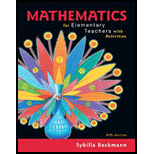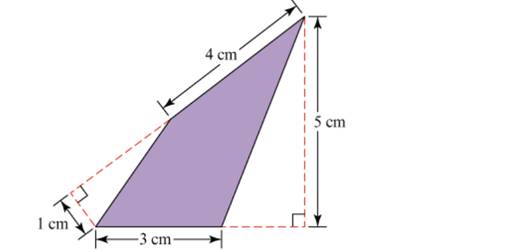
Pearson eText for Mathematics for Elementary Teachers with Activities -- Instant Access (Pearson+)
5th Edition
ISBN: 9780137442812
Author: Sybilla Beckmann
Publisher: PEARSON+
expand_more
expand_more
format_list_bulleted
Concept explainers
Textbook Question
Chapter 12.4, Problem 11P
Determine the area of the shaded region in Figure 12.57 . Explain your reasoning.

Figure 12.57 Determlne the area of the shaded region.
Expert Solution & Answer
Want to see the full answer?
Check out a sample textbook solution
Students have asked these similar questions
Determine whether the lines
L₁ (t) = (-2,3, −1)t + (0,2,-3) and
L2 p(s) = (2, −3, 1)s + (-10, 17, -8)
intersect. If they do, find the point of intersection.
Convert the line given by the parametric equations y(t)
Enter the symmetric equations in alphabetic order.
(x(t)
= -4+6t
= 3-t
(z(t)
=
5-7t
to symmetric equations.
Find the point at which the line (t) = (4, -5,-4)+t(-2, -1,5) intersects the xy plane.
Chapter 12 Solutions
Pearson eText for Mathematics for Elementary Teachers with Activities -- Instant Access (Pearson+)
Ch. 12.1 - You have a 5-foot-by-7-foot rectangular rug in...Ch. 12.1 - Draw a 3-cm-by-7-cm rectangle. Then discuss the...Ch. 12.1 - a. Explain how to decompose the large rectangle in...Ch. 12.1 - a. Explain how to decompose the large rectangle in...Ch. 12.1 - Draw a (fairly long) line segment and designate it...Ch. 12.2 - Make a shape that has area 25in2 but that has no...Ch. 12.2 - Flgure 12.14 shows the floor plan for a one-story...Ch. 12.2 - An area problem: The Johnsons are planning to...Ch. 12.2 - Figure 12.15 shows a design for an herb garden,...Ch. 12.2 - Figure 12.16 [g shows the floor plan for a modern,...
Ch. 12.2 - Use the moving and additivity principles to...Ch. 12.2 - Use the moving and additivity principles to...Ch. 12.3 - Use the moving and additivity principles to...Ch. 12.3 - For each triangle in Figure 12.31 , show the...Ch. 12.3 - Use a ruler and compass to draw three identical...Ch. 12.3 - Explain clearly in your own words why the...Ch. 12.3 - Explain clearly in your own words why the...Ch. 12.3 - Becky was asked to divide a rectangle into 4 equal...Ch. 12.3 - Explain how to use the additivity principle to...Ch. 12.3 - Determine the area of the shaded triangle that is...Ch. 12.3 - Determine the area of the shaded shape in Figure...Ch. 12.3 - Determine the area of the shaded triangle in...Ch. 12.3 - Determine the area of the shaded shape in Figure...Ch. 12.3 - Determine the area of the shaded shape in Figure...Ch. 12.3 - Given that the rectangle ABCD in Figure 12.41 has...Ch. 12.4 - Josie has two wooden beams that are 15 feet long...Ch. 12.4 - Figure 12.47 shows a shaded parallelogram inside a...Ch. 12.4 - In the text, we saw a way to explain why the area...Ch. 12.4 - Figure 12.49 shows a trapezoid. This problem will...Ch. 12.4 - Use the moving and additivity principles to...Ch. 12.4 - Find a formula for the area of a rhombus (see...Ch. 12.4 - Determine the areas (in square units) of the 4...Ch. 12.4 - Determine the area (in square units) of the...Ch. 12.4 - Determine the area of the shaded shapes in Figure...Ch. 12.4 - A rug company weaves rugs that are made by...Ch. 12.4 - Determine the area of the shaded region in Figure...Ch. 12.4 - Given that the shaded shape in Figure 12.58 is a...Ch. 12.4 - Figure 12.59 shows a map of some land. Determine...Ch. 12.5 - Figure 12.68 shows a triangle on a pegboard....Ch. 12.5 - Make a drawing to show the result of shearing the...Ch. 12.5 - Prob. 3PCh. 12.5 - Make a drawing to show the result of shearing the...Ch. 12.5 - a. Make a drawing to show the result of shearing...Ch. 12.5 - The boundary between the Johnson and the Zhang...Ch. 12.5 - Suppose that in a trapezoid ABCD, as in Figure...Ch. 12.5 - Prob. 8PCh. 12.6 - In your own words. discuss how the diameter and...Ch. 12.6 - Tim works on the following exercise: For each...Ch. 12.6 - A large running track is constructed to have...Ch. 12.6 - Suppose you have a large spool used for winding...Ch. 12.6 - Suppose that when pizza dough is rolled out it...Ch. 12.6 - Lauriann and Kinsey are in charge of the annual...Ch. 12.6 - Penguins huddle together to stay warm in very cold...Ch. 12.6 - Jack has a truck that requires tires that are 26...Ch. 12.6 - Let r units denote the radius of each circle in...Ch. 12.7 - Suppose that you have a map on which 1 inch...Ch. 12.7 - Suppose that you have a map on which 1 inch...Ch. 12.7 - Suppose that you have a map on which 1 inch...Ch. 12.8 - Suppose that a student in your class wants to know...Ch. 12.8 - Sarah is confused about the difference between the...Ch. 12.8 - Describe a concrete way to demonstrate that many...Ch. 12.8 - Anya wants to draw many different rectangles that...Ch. 12.8 - On graph paper, draw 4 different rectangles that...Ch. 12.8 - Which of the lengths that follow could be the...Ch. 12.8 - a. Without using a calculator, fund the lengths...Ch. 12.8 - Draw 4 different rectangles, all of which have a...Ch. 12.8 - Draw 4 different rectangles, all of which have...Ch. 12.8 - A forest has a perimeter of 210 mi, but no...Ch. 12.8 - Bob wants to find the area of an irregular shape....Ch. 12.8 - Consider all rectangles whose area is 4 in2 ,...Ch. 12.9 - Jessica says she doesn‘t understand the...Ch. 12.9 - Town B is 380 km due south of town A. Town C is...Ch. 12.9 - What length ribbon will you need to stretch from...Ch. 12.9 - Rover the dog is on a 30-foot leash. One end of...Ch. 12.9 - Carmina and Antone measure that the distance...Ch. 12.9 - Use the Pythagorean theorem to help you determine...Ch. 12.9 - Assuming that the earth is a perfectly round,...
Additional Math Textbook Solutions
Find more solutions based on key concepts
Length of a Guy Wire A communications tower is located at the top of a steep hill, as shown. The angle of incli...
Precalculus: Mathematics for Calculus (Standalone Book)
Complete each statement with the correct term from the column on the right. Some of the choices may not be used...
Intermediate Algebra (13th Edition)
For each hour of class time, how many hours outside of class are recommended for studying and doing homework?
Elementary Algebra For College Students (10th Edition)
Provide an example of a qualitative variable and an example of a quantitative variable.
Elementary Statistics ( 3rd International Edition ) Isbn:9781260092561
Students in a Listening Responses class bought 40 tickets for a piano concert. The number of tickets purchased ...
Elementary and Intermediate Algebra: Concepts and Applications (7th Edition)
For Problems 23-28, write in simpler form, as in Example 4. logbFG
Finite Mathematics for Business, Economics, Life Sciences and Social Sciences
Knowledge Booster
Learn more about
Need a deep-dive on the concept behind this application? Look no further. Learn more about this topic, subject and related others by exploring similar questions and additional content below.Similar questions
- Find the distance from the point (-9, -3, 0) to the line ä(t) = (−4, 1, −1)t + (0, 1, −3) .arrow_forward1 Find a vector parallel to the line defined by the parametric equations (x(t) = -2t y(t) == 1- 9t z(t) = -1-t Additionally, find a point on the line.arrow_forwardFind the (perpendicular) distance from the line given by the parametric equations (x(t) = 5+9t y(t) = 7t = 2-9t z(t) to the point (-1, 1, −3).arrow_forward
- Let ä(t) = (3,-2,-5)t + (7,−1, 2) and (u) = (5,0, 3)u + (−3,−9,3). Find the acute angle (in degrees) between the lines:arrow_forwardNo chatgpt pls will upvotearrow_forwardA tank initially contains 50 gal of pure water. Brine containing 3 lb of salt per gallon enters the tank at 2 gal/min, and the (perfectly mixed) solution leaves the tank at 3 gal/min. Thus, the tank is empty after exactly 50 min. (a) Find the amount of salt in the tank after t minutes. (b) What is the maximum amount of salt ever in the tank?arrow_forward
- Draw a picture of a normal distribution with mean 70 and standard deviation 5.arrow_forwardWhat do you guess are the standard deviations of the two distributions in the previous example problem?arrow_forward1 What is the area of triangle ABC? 12 60° 60° A D B A 6√√3 square units B 18√3 square units 36√3 square units D 72√3 square unitsarrow_forward
- Each answer must be justified and all your work should appear. You will be marked on the quality of your explanations. You can discuss the problems with classmates, but you should write your solutions sepa- rately (meaning that you cannot copy the same solution from a joint blackboard, for exam- ple). Your work should be submitted on Moodle, before February 7 at 5 pm. 1. True or false: (a) if E is a subspace of V, then dim(E) + dim(E) = dim(V) (b) Let {i, n} be a basis of the vector space V, where v₁,..., Un are all eigen- vectors for both the matrix A and the matrix B. Then, any eigenvector of A is an eigenvector of B. Justify. 2. Apply Gram-Schmidt orthogonalization to the system of vectors {(1,2,-2), (1, −1, 4), (2, 1, 1)}. 3. Suppose P is the orthogonal projection onto a subspace E, and Q is the orthogonal projection onto the orthogonal complement E. (a) The combinations of projections P+Q and PQ correspond to well-known oper- ators. What are they? Justify your answer. (b) Show…arrow_forwardpleasd dont use chat gptarrow_forward1. True or false: (a) if E is a subspace of V, then dim(E) + dim(E+) = dim(V) (b) Let {i, n} be a basis of the vector space V, where vi,..., are all eigen- vectors for both the matrix A and the matrix B. Then, any eigenvector of A is an eigenvector of B. Justify. 2. Apply Gram-Schmidt orthogonalization to the system of vectors {(1, 2, -2), (1, −1, 4), (2, 1, 1)}. 3. Suppose P is the orthogonal projection onto a subspace E, and Q is the orthogonal projection onto the orthogonal complement E. (a) The combinations of projections P+Q and PQ correspond to well-known oper- ators. What are they? Justify your answer. (b) Show that P - Q is its own inverse. 4. Show that the Frobenius product on n x n-matrices, (A, B) = = Tr(B*A), is an inner product, where B* denotes the Hermitian adjoint of B. 5. Show that if A and B are two n x n-matrices for which {1,..., n} is a basis of eigen- vectors (for both A and B), then AB = BA. Remark: It is also true that if AB = BA, then there exists a common…arrow_forward
arrow_back_ios
SEE MORE QUESTIONS
arrow_forward_ios
Recommended textbooks for you
 Glencoe Algebra 1, Student Edition, 9780079039897...AlgebraISBN:9780079039897Author:CarterPublisher:McGraw HillAlgebra & Trigonometry with Analytic GeometryAlgebraISBN:9781133382119Author:SwokowskiPublisher:Cengage
Glencoe Algebra 1, Student Edition, 9780079039897...AlgebraISBN:9780079039897Author:CarterPublisher:McGraw HillAlgebra & Trigonometry with Analytic GeometryAlgebraISBN:9781133382119Author:SwokowskiPublisher:Cengage Holt Mcdougal Larson Pre-algebra: Student Edition...AlgebraISBN:9780547587776Author:HOLT MCDOUGALPublisher:HOLT MCDOUGAL
Holt Mcdougal Larson Pre-algebra: Student Edition...AlgebraISBN:9780547587776Author:HOLT MCDOUGALPublisher:HOLT MCDOUGAL
 Elementary Geometry For College Students, 7eGeometryISBN:9781337614085Author:Alexander, Daniel C.; Koeberlein, Geralyn M.Publisher:Cengage,
Elementary Geometry For College Students, 7eGeometryISBN:9781337614085Author:Alexander, Daniel C.; Koeberlein, Geralyn M.Publisher:Cengage,

Glencoe Algebra 1, Student Edition, 9780079039897...
Algebra
ISBN:9780079039897
Author:Carter
Publisher:McGraw Hill

Algebra & Trigonometry with Analytic Geometry
Algebra
ISBN:9781133382119
Author:Swokowski
Publisher:Cengage

Holt Mcdougal Larson Pre-algebra: Student Edition...
Algebra
ISBN:9780547587776
Author:HOLT MCDOUGAL
Publisher:HOLT MCDOUGAL


Elementary Geometry For College Students, 7e
Geometry
ISBN:9781337614085
Author:Alexander, Daniel C.; Koeberlein, Geralyn M.
Publisher:Cengage,

Sequences and Series Introduction; Author: Mario's Math Tutoring;https://www.youtube.com/watch?v=m5Yn4BdpOV0;License: Standard YouTube License, CC-BY
Introduction to sequences; Author: Dr. Trefor Bazett;https://www.youtube.com/watch?v=VG9ft4_dK24;License: Standard YouTube License, CC-BY